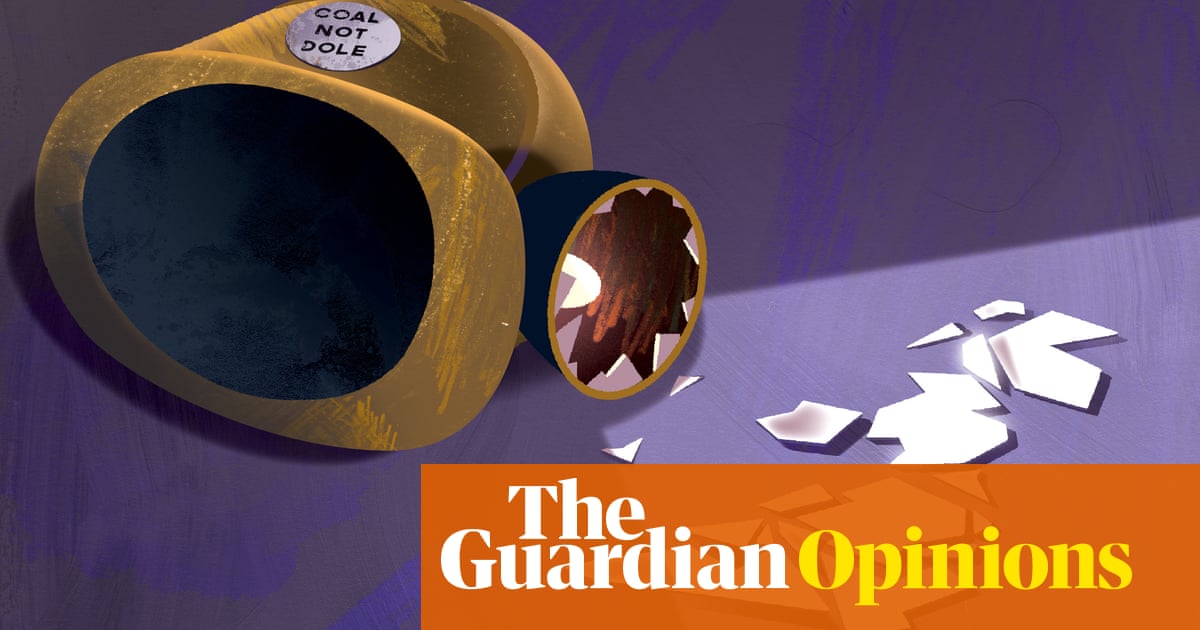
Abattery sign, flashing dangerously low, appears superimposed over a view of the globe as seen from space. “Green technologies, electric cars, clean air – all of these depend on one of the most significant lithium deposits in the world, which is located right here in Jadar, Serbia,” a gravel-voiced narrator announces. “We completely understand your concerns about the environment. Rio Tinto is carrying out detailed analyses, so as to make all of us sure that we develop the Jadar project in line with the highest environmental, security and health standards.”
Beamed into the country’s living rooms on the public service channel RTS, the slick television ad, shown just after the evening news, finishes with images of reassuring scientists and a comforted young couple walking into the sunset: “Rio Tinto: Together we have the chance to save the planet.”
The pivot to ecological saviour and bastion of transparency is perhaps an unlikely one for Rio Tinto, the world’s second-largest metals and mining corporation.
Throughout its almost 150-year history, the Anglo-Australian multinational, which posted profits after tax of $10.4bn (£7.3bn) in 2020, has faced accusations of corruption, environmental degradation and human rights abuses.
It is currently fighting a civil lawsuit by the US Securities and Exchange Commission that accuses the company of fraud at its Mozambique coal business. That follows a £27.4m fine in 2017 from the UK’s financial watchdog for breaching disclosure and transparency rules.
The chief executive of Rio Tinto’s iron ore operation, Simon Trott, conceded earlier this year that the company was “not proud of its history” at its Marandoo mine in Western Australia where hundreds of ancient artefacts were thrown into a rubbish dump. Last year, the then chief executive resigned after the company deliberately blew up an ancient cave, one of Australia’s most significant archaeological research sites, where there had been evidence of 46,000 years of continual occupation. This summer the company finally agreed, after decades of appeals, to fund an “environmental and human rights impact assessment” of its former copper and goldmine in Panguna, in Papua New Guinea, where it is claimed that 1bn tonnes of mine waste was dumped into the Kawerong-Jaba river delta and continues to wreak catastrophic damage.
It is a troubling history. One critic has said Rio Tinto could be seen as “a poster child for corporate malfeasance”. But for Rio Tinto executives the future is also a cause for concern despite current bumper profits. The share price has been struggling. The price of iron ore is under pressure from massive Chinese production. Scandals in Australia have put its future expansion in jeopardy and the company’s management of a major copper mine in Mongolia has come under heavy criticism.
It is in that context that the world’s dash for decarbonisation and the European Union’s drive for self-sufficiency in raw materials to achieve its climate targets have caught the company’s eye.
In July, Rio Tinto announced that it would invest $2.4bn in a project in the Jadar valley, in western Serbia, overlooked by the Cer and Gučevo mountains, building what it says will be Europe’s biggest lithium mine, and one of the world’s largest on a greenfield site.
The company estimates that over the expected 40-year life of the mine, it will produce 2.3m tonnes of battery-grade lithium carbonate, a mineral critical for large-scale batteries for electric vehicles and storing renewable energy, and 160,000 tonnes of boric acid annually, necessary for the renewable energy equipment such as solar panels and wind turbines.
Rio Tinto boasts the mine will make it one of the top 10 lithium producers in the world, and could produce enough for more than 1m electric cars a year, of which annual sales are expected to jump from 1.2m vehicles in 2017 to at least 23m in 2030, according to the International Energy Agency.
The EU, with which Serbia has an association agreement facilitating trade and regional funding, imports all its battery-grade lithium from outside Europe. Talks about supplying leading German car manufacturers have begun. Four 40ft shipping containers carrying the infrastructure for a lithium processing plant have set sail for Serbia from Australia.
The project is gathering momentum. But anxious and angry campaigners, including the thousands of protesters who have taken to the streets of the Serbian cities of Loznica and Belgrade over recent months, say they are witnessing an unfolding disaster in the country’s “breadbasket”, responsible for around a fifth of total agricultural production, raising questions about the strange bedfellows being made in the maelstrom of the green revolution, and whether lessons have been learned about consumption and production that has made the transition to a decarbonised world so urgent.
Shortcomings in Serbian democracy further raise concerns over whether the voices of those on the frontline are being heard.
It is 17 years since lithium, a silvery-white alkali metal, was discovered by chance by Rio Tinto geologists in one of two boreholes in a cornfield in Jadar valley.
The team had been looking for borates, used in fertiliser and building materials, but found something unexpected: borates and lithium in one mineral, a combination that would later be given the name jadarite, after the valley.
Marijana Petkovic, 47, a teacher , lives with her husband, Nebojša, 49, and two daughters in Gornje Nedeljice, one of the nine villages that will be most affected by the planned mine. She remembers the day the Rio Tinto men arrived.
“They were taking samples and were around all the time. We got to know them, they would be invited in for coffee, lunch, for saints’ days and local events – they were Serbian,” she said. “They were talking about a small mine then, 20 hectares, and that we would never even know it was here.”
Over the following years, donations started to be made by Rio Tinto to local causes. Gornje Nedeljice’s school received funds for classroom renovations. The football team’s clubhouse got a new roof and farmers were offered vouchers for expensive agricultural equipment. There was even cash for the Christmas bazaar among the 107 donations dished out since 2003, of a total value of $608,807 (£451,034).
“After a year or two, the mine was suddenly going to be 80 hectares,” said Petkovic. “Then in September last year, we received letters telling us that our land had been rezoned from being agricultural to building land. I remember a friend invited me to her house where a group of us women were asked by a lady from Rio Tinto about what we wanted from the mine, what opportunities might interest us … We were idiots. We weren’t paying attention.”
Rio Tinto said it did not recognise the figures cited by Petkovic but conceded that plans had evolved. According to the spatial plan published by the Serbian government in March, the zone at risk of subsidence will be spread across 850 hectares, the size of more than 1,000 football pitches.
The core mine will be on a site of just over 200 hectares on a bank of the Korenita River, a tributary of the Jadar, with further hundreds of hectares set aside for landfills of waste and new transport infrastructure. Excavation will take place underneath the two riverbeds where lithium has been identified at depths of 100 to 650 metres.
In 2014, flooding of the Korenita led to a dam overflowing into a closed coalmine, spilling toxic material over farmland. Rio Tinto says it plans to convert the liquid waste from the mine into dry “cakes” to make it safer to store. It is making contingency plans for a “once in 10,000 years flood event”, just in case.
The mine will involve the relocation of 81 households, voluntary or otherwise, and the purchase of fields of 293 landowners. A brochure circulated among those affected stated that expropriation of homes and land would be a “last resort”.
The company has already bought up about 80% of the land and property, for what are said to be “unheard of” sums, according to Petkovik, amounting to hundreds of thousands of euros in some cases, based on payouts of €470 (£397) per sq metre of a property. Rio Tinto is offering 5% bonuses to those who complete within four months of an offer.
About 30 homes have been bought in Petkovic’s village. Knowing their properties are destined to be destroyed, the owners rip out windows, doors and even roofs, leaving desolate scenes for those who have resisted Rio Tinto’s money or are yet to be offered anything. “Our neighbours did it so we had to,” said Živana Šakic, 67, who recently sold up.
Close to the proposed works, lies the Paulje necropolis dated 1500-1000BC, the biggest central Balkans cemetery from the bronze age.
Rio Tinto has paid a local museum for an archaeological dig and hundreds of artefacts including pottery, jewellery, tools made of painted stone and bronze, aceramic spool and a three-legged altar have been uncovered so far.
Zlatko Kokanovic, 45, a vet who farms about 32 hectares with his brother, in which a five bronze age graves are located, said he had rejected attempts by Rio Tinto to lease the land for excavation. “They will never buy me off – they can only steal it from me,” the father of five said.
“The Jadar project will not have any impact on this important site in any of its phases,” Rio Tinto said.
There are also two Important Bird and Biodiversity Areas internationally recognised as important for the conservation of bird populations. “But so far no risks have been identified for the existing fauna in these zones … No activities have been or will be carried out during the period of active nesting of birds,” added the company spokesperson.
Obtaining lithium will nevertheless entail a heavy environmental toll, generating 57m tonnes of waste over the mine’s life of rock material and industrial detritus.
The average water demand is estimated to be 6-18 litres a second, or about 1.3 litres of water for every kilo of product. As for carbon emissions, the company says on its website that it “anticipates” using renewable energy.
“Such mines are mostly opened in deserts precisely because of the detrimental effect on the environment and biodiversity,” said Prof Dragana Đorđević, head of environmental chemistry and engineering at the University of Belgrade. “The basins of the Drina and Sava rivers, from which about 2.5 million people are supplied with water, are endangered.” Rio Tinto deny this.
Rio Tinto has commissioned 12 environmental studies, none of which the company would make available when asked by the Guardian. The company also declined requests for an interview.
But one study funded by the company, summarised in a slide presentation obtained by this newspaper, offers an insight. Dr Imre Krizmanic, from the biology faculty at the University of Belgrade, found that attempts to mitigate the damage to more than 145 protected species , from wolves, beavers and bats to salamanders, pond turtles, dragonflies, fish, flora and fauna, would have a highly limited impact.
The presentation concluded that “due to the expected irreversible changes in certain ecosystems, as well as risks of significant endangerment of the living world of the rivers Jadar, Drina and downstream watercourses, the optimal and basic measure to prevent the negative consequences of the state of biodiversity in this area is the abandonment of planned exploitation and processing of the mineral jadarite”.
While the Jadar project does not yet have the permits necessary for construction, Rio Tinto is confident that the Serbian ministry of environment will give the green light when it submits its environmental impact assessment (EIA) later this year.
A Rio Tinto spokesperson said of the core site, “almost all species at this location can be found in western Serbia or beyond. In other words, there are no species that cannot continue their life beyond this territory, meaning that impact on biodiversity will be minimal.”
Serbia’s president, Aleksandar Vučić, told a TV chatshow in January: “We do not have sea or natural resources that will bring us millions. We have jadarite, and I’m dying with laughter when I hear that people are protesting over it. They are protesting down there, in western Serbia, over Rio Tinto and they say it will be a disaster. No, it will not. No disaster will happen there.”
Vučić has suggested he could open up the issue to a referendum but Miroslav Mijatović, from NGO, the Podrinje Anti-Corruption Team (Pakt), worries that the government is revising the rules over such votes. “Both the previous government and this current government are clientelistic towards the company and adapt the laws to their needs,” he said.
As for the potential electoral threat posed by the unpopular mine, minutes of a meeting between the European Commission and Rio Tinto executives, released under freedom of information laws, note in bold that EU officials had been informed that “site development [will] start – from [the second quarter] of 2022 – after the elections in Serbia (March 2022)”.
Rio Tinto says it will create 2,000 jobs during the mine’s construction and 1,000 long-term positions, making a 1% direct and 4% indirect contribution to GDP. But people fighting the plan find it difficult to see beyond the imminent destruction of a longstanding community and way of life.
Dragan Karajcic, 51, leader of the parish council, who has corn and soya fields close to what will be the landfill site, said Rio Tinto’s record had been that of leaving “deserts behind”. “Even if they were planning a chocolate factory in the name of Rio Tinto I wouldn’t give up my land”, he said.
Beekeeper Vladan Jakovljevic, 60, from Stupinica, 2km from the mining zone, whose 400 hives produced three tonnes of acacia honey last year, said the area where his bees feed would be left “desolate.”
Ratko Ristic, a forestry professor has lobbied with others from the Serbian Academy of Sciences and Arts against the Jadar mine, claiming “the possible benefits for the state of Serbia is between €7m to €30m a year, the possible income from advanced agricultural activity in the same area would be more than €80m a year without pollution or relocation”.
A petition against the mine has more than 130,000 signatures, 2% of the Serbian population. The company has already had to pay small sums in damages due to leakage in fields where it has carried out research.
Pakt has filed a criminal report with the basic public prosecutor’s office in Loznica against Rio Tinto, incorporated in Serbia as Rio Sava Exploration, claiming it has acted contrary to its research permits by illegally dumping rubble, and that lorries have driven over weak bridges.
Rio Tinto said it had not been contacted over the claims, and “the competent authorities have confirmed that the activities of Rio Sava Exploration are in line with applicable legislation”.
The company’s assurances, however, that its operations will be in compliance with Serbian and European regulations, offer little succour to locals.
While Serbia is obliged to align its water and waste management and industrial emissions regulations with the EU, as part of its route to joining, the European Commission conceded in a letter to lawyers for the Mars Sa Drine (March on Drina) anti-mine campaign that while Serbia “has achieved some progress regarding the alignment with the European legislation … implementation is still at an early stage”.
Lucas Bednarsk, author of Lithium: The Global Race for Battery Dominance and the New Energy Revolution, said a moral argument could be made that Europe should bear the ecological costs of the lithium excavation it needs. It is currently imported from Australia, Latin America and China.
But Meadhbh Bolger, from Friends of the Earth Europe, says that batteries for electric vehicles and renewables are predicted to drive up demand for lithium by almost 6,000% by 2050 – and asked why such consumption was not being questioned.
“There is still no talk about reducing demand,” says Bolger. “We have asked the question and the commission said they were not at the stage that they could address constraint. The reason we got to where we are in the first place is by exploiting the resources, too much extraction, to meet the needs of the luxury rich and European industry … We are just doing it again.”











